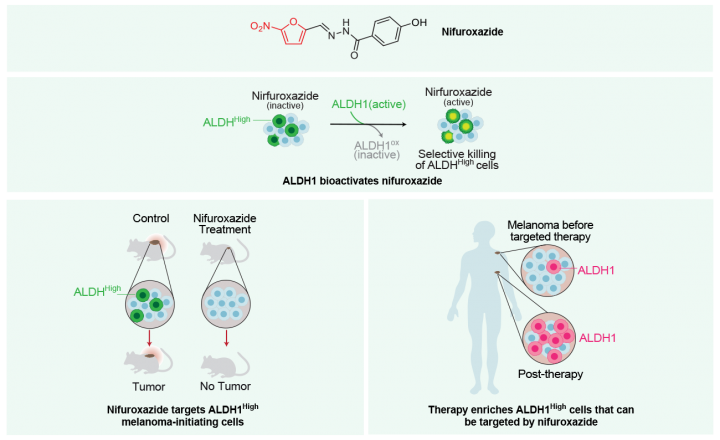Antibiotic may selectively kill dangerous skin cancer cells
Patton and IGMM colleagues demonstrate potential use for nifuroxazide in melanoma: October 2018

IGMM scientists have discovered that an old antibiotic, called nifuroxazide, could selectively kill dangerous cells within melanomas, the deadliest type of skin cancer. Professor Liz Patton and colleagues at the MRC Human Genetics Unit and Cancer Research UK Edinburgh Centre found the drug showed promise for complementing existing melanoma therapies. The drug’s effect on melanoma cells was tested in mice and samples from human tumours though the scientists caution more research is needed to determine if it will be effective in people.
Within a single tumour there can be variation in the properties of the cells, with some more dangerous than others, in terms of their potential to support growth or become resistant to drug treatment. Many of the more dangerous cells in melanoma tumours produce a lot of an enzyme called aldehyde dehydrogenase 1 (ALDH1).
Current research into therapies has focused on blocking ALDH1, but in this study the researchers went a step further and aimed to selectively kill cells producing high ALDH1.
They used the drug nifuroxazide, an antibiotic, which is taken in an inactive state and is activated by the enzyme (ALDH1). This means that it only becomes toxic once it is inside cells producing ALDH1.
The researchers showed using samples of human melanomas implanted in mice that the nifuroxazide therapy killed the tumour cells that produced a lot of ALDH1, without significant toxicity to other cells in the body.
The researchers hope that the strategy may complement existing melanoma treatments, called BRAF and MEK inhibitors. Currently, some people’s tumours develop resistance to BRAF and MEK inhibitors and the researchers found that some of these resistant tumours were high in ALDH1.
In the lab, the researchers simulated this by treating cancer cells lines with BRAF and MEK inhibitors, which increased the number of cells with high levels of ALDH1 and made the cells especially sensitive to nifuroxazide treatment.
There won’t be one magic bullet for targeting melanoma – the variations that exist within the cancers mean there will need to be combination therapies. When people are given BRAF or MEK drugs to treat melanoma it can result in the tumours having more cells with high levels of ALDH, so we think that’s a really important target. We’ve shown this antibiotic that’s used mostly to target intestinal bacteria can also target and kills cancer cells high in the enzyme ALDH1.
It’s great that this antibiotic is approved for use in humans, but it wasn’t designed as a cancer drug, so we still need to find out if it’s safe and effective for cancer in humans. We’re also starting to look into if nifuroxazide could be helpful in other types of cancer that have high ALDH1, such as ovarian cancer.
The researchers were primarily supported by the MRC, the Cancer Research UK Edinburgh Centre, the European Research Council, and the L’Oreal-Melanoma Research Alliance.
Links
Research article: https://doi.org/10.1016/j.chembiol.2018.09.005
L’Oreal-Melanoma Research Alliance: https://www.curemelanoma.org/


